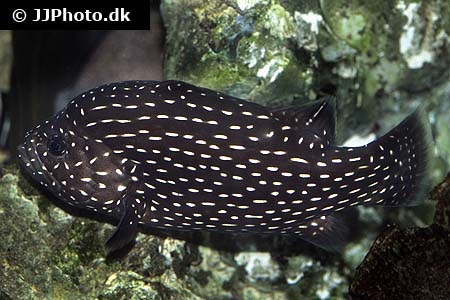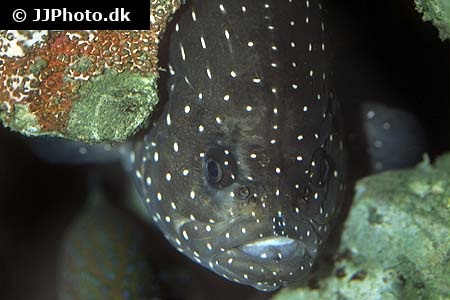Grammistes sexlineatus


| Latin name | Grammistes sexlineatus - (Thunberg, 1792) |
|---|---|
| Local name | Goldenstriped soapfish |
| Family | Serranidae - Grammistes |
| Origin | East Indian Ocean, West Indian Ocean, Australia, The Red Sea, Indonesia, East Pacific, Central/West Pacific |
| Max length | 30 cm (11.8") |
| Minimum volume |
500 l (132 gal) |
|---|---|
| Hardiness |
Hardy |
| Suitable for aquarium |
Experience, preparation and extra care required |
| Reef safe |
Reef safe with caution |
| Aggressiveness | Mostly peaceful but might be aggressive towards similar species |
| Recommended |
Fish Larger crustaceans (Shrimp, crabs...) Other invertebrates Small crustaceans (Krill, mysis, artemia...) |
|---|
This species eats all kinds of fish, shrimps, crabs etc. which are of suitable size.
This species can release poison into the water when stressed. It can be fatal to fish and other sea creatures.
Never add the water used to transport it, into an aquarium.
Be mindful that catching these fish with a net, will cause a lot of stress by chasing it round the tank.
This species must be fed with an appropriately varied diet.
These fish flourish better without other members of the same species in the aquarium.
This species eats a great deal and demands an aquarium that can tolerate such a heavy load.
There is a greater chance of success with this species if one can supply a living feed to allow it to adapt to the tank.
This species needs good hiding places, for example, between live rocks.
This species is nocturnal and therefore the most active when the light is dimmed or turned off.
When young these fish can resemble Cardinalfish, such as Apogon novemfasciatus.
The Sea Bass family (Serranidae) spans a broad spectrum with regards to how suitable they are to aquaria, as some are best suited to specialist or larger aquaria, while other are often seen in reef aquaria.
Below are described the five subfamilies one sees most often in aquaria. There are however other species one can also keep under the right circumstances, but these are for the most, large predatory fish.
Anthias (Anthiinae)
The Anthias species spans over many different genera, but the most common is the Pseudanthias genus. They mostly have an attractive orange or pink shade.
They are generally all reef safe and peaceful.
There is however a large difference to their food requirements, some species demand constant feeding, whereas others can get used to being fed once a day.
The easiest species are the following: P. bartelettorum, Anthias, Luzonichthys, Nemanthias, Odontanthias, Pseudanthias, Sacura and Serranocirrhitus
Liopropomatinae
This subfamily encompasses some of the smallest fish in the Serranidae family, they can be very colourful but shy. The Liopropoma genus encompasses many species which are suitable for aquaria, however they normally thrive best in a very peaceful- or nano aquarium.
Grouper (Epinephelinae)
These fish grow typically too large for most home aquaria. There are however some species that do lend themselves to the slightly bigger domestic aquarium. Several of the species look very impressive and often have a interesting personality, and they often recognize the aquarist and will become tame over time.
Groupers are predatory fish and eat everything they can swallow; fish, crabs, shrimps and sometimes other invertebrates. Like most large predatory fish they excrete a lot of nutrients to the water, so one therefore needs a good filter system.
Groupers include among others the following genera: Aethaloperca, Cephalopholis, Chromileptes, Epinephelus, Paranthias and Pogonoperca
Soapfishes (Grammistinae)
These fish are like the Groupers predatory fish, but they do not typically, grow so large. They are relatively hardy, but some of the species demand a thorough preperation if one wants to be successful.
Soapfishes are generally very shy and will often hide under an overhang during the day, and hunt at night.
Soapfishes include among others the genera: Grammistes
Serraninae
The most common genera in captivity is Dwarf Seabasses (Serranus) and Hamlets (Hypoplectrus).
See the description of the individual genera below.
| Aquarium trade | Yes |
|---|---|
| Distribution | Indo-Pacific: Red Sea to the Marquesan and Mangaréva islands, north to southern Japan, south to New Zealand (Ref. 5755). |
| French common names |
Savonnette Savon à raies d'or Vieille plate canal Feuille de canne à sucre Mérou à rayures d'or Poisson savon bagnard |
| English common names |
Soapfish Sixstripe soapfish Skunkfish Sixline soapfish Lined soapfish Golden-striped soapfish Goldenstriped soapfish Goldstriped soapfish Black and white striped soapfish |
| Danish common names |
Gulstribet sæbefisk |
| German common names |
Goldstreifenbarsch |
Scott W. Michael. 2001. Basslets, Dottybacks & Hawkfishes: v. 2 (Reef Fishes) TFH Publications / Microcosm Ltd. - (English)
Bob Fenner. The Soapfishes, Family Grammistidae, or Tribe Grammistini of the Serranidae, in part, or... - Wet Web Media - (English)
WWM Crew. FAQs about the Basses called Soapfishes - Wet Web Media - (English)
Bob Fenner. The Basses, Family Serranidae - Wet Web Media - (English)

